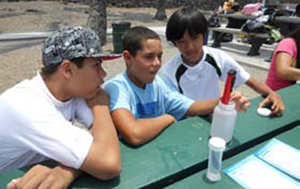Our Ways of Knowing:
Meet the 2010 Mellon-Hawai‘i Fellows
Leilani Basham, Ph.D., Political Science (2007), University of Hawai‘i at Mānoa
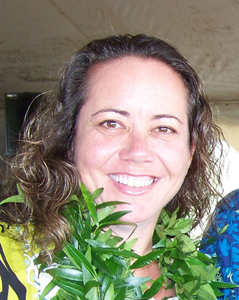 Photo: 2010 Mellon–Hawai‘i Postdoctoral Fellow Leilani Basham.
Photo: 2010 Mellon–Hawai‘i Postdoctoral Fellow Leilani Basham.
‘O ka pono ke hana ‘ia a iho mai nā lani. This ʻōlelo noʻeau (Hawaiian proverb) encapsulates my feelings about receiving the fellowship; it is truly a gift, a blessing, a privilege, and an opportunity. It will allow me to continue learning and producing knowledge for this and future generations of Hawaiians that is centered on our ways of knowing, our ways of being, and our ways of understanding our world in terms of our language, history, politics, and culture. I hope that my work will contribute to our collective body of knowledge not only in theoretical terms, but also in terms of action and practice, and that it will continue to be expanded and built upon by the next generation of Native Hawaiian scholars and practitioners. —Dr. Leilani Basham
Dr. Leilani Basham received her doctorate degree in political science in 2007 from the University of Hawai‘i at Mānoa, where she also earned a bachelor’s in Hawaiian studies and a master’s in the history of the Pacific Islands. She is an assistant professor in the Hawaiian-Pacific Studies program at the University of Hawai‘i – West O‘ahu, teaching both Hawaiian language and Hawaiian studies. Her research centers on understanding Hawaiian history, political and cultural knowledge, and practice from a Hawaiian perspective, using predominantly Hawaiian language resources. Specific areas of research include mele lāhui, Hawaiian identity and value systems, as well as Hawaiian sexuality. Her book project is entitled "Nā Mele Lāhui: E Mau ke Ea o ka ‘Āina i ka Pono," and it analyzes hundreds of mele lāhui (nationalist poetic texts) published between 1893 and 1898. In addition to her university studies, Basham spent fifteen years studying hula under her kumu (teacher), graduating as an ‘ōlapa (dancer) and a kumu hula. Currently, she is the kumu hula of her own hālau (private hula academy).
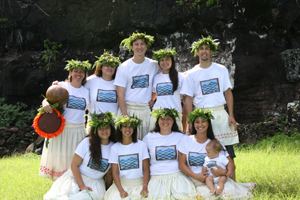 Photo: Leilani Basham (top row, far left) with students of Hālau Kupukupu Ke Aloha at Kē‘ē, Kaua‘i.
Photo: Leilani Basham (top row, far left) with students of Hālau Kupukupu Ke Aloha at Kē‘ē, Kaua‘i.
Basham’s mentor is Dr. Noenoe K. Silva, assistant professor in the Department of Political Science at the University of Hawai‘i at Mānoa. “Basham is doing cutting edge research that combines a deep knowledge of Hawaiian language, mele, hula, and history with incisive political analysis,” Silva said. “Basham's work has thus pushed Hawaiian studies up to a higher level by combining research in Hawaiian language and mele with historical-political analysis. Her research, for example, gives us new (and old!) ways of thinking of key concepts in Hawaiian political thought, such as ea (breath, life, sovereignty) and pono. Currently, the dissertation is only available to those fluent in Hawaiian, so it is very important that she write an English version as a book that will be accessible to everyone.”
The Mellon-Hawai‘i Fellowship Program is making an important difference in the lives of everyone in Hawai‘i. By providing fellowships they are helping Kanaka Hawai‘i complete their dissertations and go on to do important work in higher education and other arenas. Their post-doctoral fellowships are providing the precious time needed for our Kanaka scholars to turn their dissertations into books, which everyone in our communities can read, learn from, teach from, and enjoy. The Mellon-Hawai‘i Fellowship program is allowing these advances in scholarship to happen much faster than they ordinarily would.
—Dr. Noenoe K. Silva
Noelani Goodyear-Ka‘ōpua, Ph.D., (2005), University of California, Santa Cruz
Photo: Mellon-Hawai‘i Postdoctoral Fellow Noelani Goodyear-Ka‘ōpua and her daughters, Hina (age 10) and La‘i (age 1).
I strive to be an educator and public intellectual who will foster visions of a world based in ecological balance, justice, constructive intercultural engagement, and life-long learning. High on my list of professional goals is to make education relevant to students’ lives and to guide them in developing useful skills for academic and political intervention, as well as intercultural communication. —Dr. Noelani Goodyear-Ka‘ōpua
Dr. Noelani Goodyear-Ka‘ōpua is an assistant professor of political science at the University of Hawai‘i at Mānoa, where she teaches courses in Hawaiian politics, indigenous politics, and decolonial futures. Goodyear-Ka‘ōpua earned a doctorate degree at the University of California, Santa Cruz’s History of Consciousness program in 2005. She is also a graduate of Kamehameha Schools and received a bachelor’s Magna Cum Laude from the University of Hawai‘i at Mānoa in Hawaiian studies and political science.
 Photo: Noelani Goodyear-Ka‘ōpua with baby daughter La‘i, working with a lo‘i and wetland restoration project, Mahuahua ‘ai o Hoi, in He‘eia. Led by members of the community and Ko‘olaupoko Hawaiian Civic Club (Rocky and Jerry Kaluhiwa, Mahelani Cypher, and Alice Hewett) with Kanekoa Shultz, the project aims to restore the health of the ahupua‘a by putting the wetland mauka of He‘eia fishpond back into kalo production. “I was raised in He‘eia, and I hope to support this community-based project in the coming years,” says Goodyear-Ka‘ōpua.
Photo: Noelani Goodyear-Ka‘ōpua with baby daughter La‘i, working with a lo‘i and wetland restoration project, Mahuahua ‘ai o Hoi, in He‘eia. Led by members of the community and Ko‘olaupoko Hawaiian Civic Club (Rocky and Jerry Kaluhiwa, Mahelani Cypher, and Alice Hewett) with Kanekoa Shultz, the project aims to restore the health of the ahupua‘a by putting the wetland mauka of He‘eia fishpond back into kalo production. “I was raised in He‘eia, and I hope to support this community-based project in the coming years,” says Goodyear-Ka‘ōpua.
Her dissertation, “Ku i ka Mana: Building community and nation through contemporary Hawaiian schooling,” examined emergent efforts of educators at Kamehameha Schools and Hālau Kū Māna charter school to disarticulate schooling from its colonial history and rearticulate schools within growing movements for Kanaka Maoli (Native Hawaiians) self-determination and well-being. During her fellowship year, she will be revising that work as a book manuscript entitled, “Teaching Nation: Struggles for Hawaiian Schools and Sovereignty.” “Teaching Nation”provides a critical history of Hawaiian education as it emerges out of the work of Kanaka Maoli educational innovators of the nineteenth, twentieth, and early twenty-first centuries. She is mentored by Charles R. Lawrence III, J.D., William S. Richardson School of Law, Centennial University Professor, University of Hawai‘i at Mānoa, and Professor of Law, Georgetown University Law Center in Washington, D.C.
Goodyear-Ka‘ōpua says the ethics and practices of aloha ‘āina, which she defines as “love for land and country, Hawai‘i,” guide her academic and community work. Over the last 15 years, she has worked alongside other Kanaka to change the cultural and political aims of education in Hawai‘i and to stand for Hawaiian self-determination and sovereignty. She is a co-founder of Hālau Kū Māna public charter school and currently serves as the local school board chair.
Keao NeSmith, doctoral candidate in Applied Linguistics at the University of Waikato in Hamilton, New Zealand
The most driving thought of mine as I pursue my Ph.D. is how exactly I can support my home community in Kekaha, Kaua‘i, and help ensure that the language of native speakers of Hawaiian continues in as true a form to the original as possible as it is taught to Hawaiian language learners. —Keao NeSmith
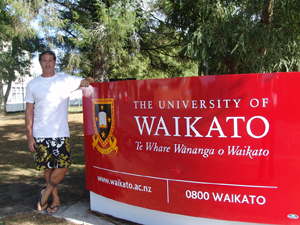 Photo: 2010–2011 Mellon-Hawai‘i Doctoral Fellow Keao NeSmith at the University of Waikato in Hamilton, New Zealand.
Photo: 2010–2011 Mellon-Hawai‘i Doctoral Fellow Keao NeSmith at the University of Waikato in Hamilton, New Zealand.
Kaua‘i-born Keao NeSmith attended Kekaha Elementary School, Waimea Canyon School, and Waimea High School and graduated from Kamehameha Schools. He earned a bachelor’s degree in Hawaiian studies with an emphasis on language at the University of Hawai‘i at Hilo, and an M.A. in Pacific Islands studies at the University of Hawai‘i at Mānoa. His area of interest is Hawaiian language continuity in the era of Hawaiian language revitalization. He is currently a doctoral candidate in applied linguistics at the University of Waikato in Hamilton, New Zealand.
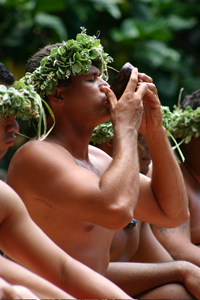
His doctoral dissertation is entitled, "The teaching and learning of Hawaiian language and culture in public high schools and tertiary level schools in Hawai‘i: Issues relating to linguistic and cultural continuity and discontinuity." The main question driving his doctoral thesis is how Hawaiian is being taught in classrooms today and what are the best methods for teaching additional languages. NeSmith is mentored by Winifred H. Crombie, Ph.D., Associate Professor (Language and Language Education), School of Māori and Pacific Development (SMPD), Te Pua Wānanga ki te Ao, University of Waikato in New Zealand.
Photo: Keao participating in an ‘awa ceremony at Nu‘alolo Kai, Kaua‘i in July 2005.“The main focus of Keao’s research is the teaching and learning of Hawaiian language and culture but his findings thus far are likely to have very important implications for the teaching and learning of indigenous languages throughout the world,” Crombie said.
Hiapokeikikāne Kichie Perreira, doctoral candidate in the Hawaiian and Indigenous Language and Culture Revitalization Program at the University of Hawai‘i at Hilo
 Photo: Hiapokeikikāne Kichie Perreira at a recent book signing event with Dr. William “Pila” Wilson (left) and 2009–2010 Mellon-Hawaiʻi Doctoral Fellow Kauanoe Kamanā (right).
Photo: Hiapokeikikāne Kichie Perreira at a recent book signing event with Dr. William “Pila” Wilson (left) and 2009–2010 Mellon-Hawaiʻi Doctoral Fellow Kauanoe Kamanā (right).
The knowledge unselfishly given from kūpuna of the Niʻihau community, coupled with my experience of the desire of Hawaiian immersion children to learn, grew in me an unrelenting zeal to constantly develop into the best that I can be for the benefit of generations to come. —Hiapokeikikāne Kichie Perreira
Doctoral Fellow Hiapokeikikāne Kichie Perreira was raised in Kapahulu and Waiau on Oʻahu. A 1992 graduate of Kamehameha Schools, he received a bachelor's degree in Hawaiian studies from the University of Hawaiʻi at Hilo (UH Hilo) and was the first UH Hilo graduate student to receive a master's degree in Hawaiian language and literature. Since 1996, he has lectured at Ka Haka ʻUla O Keʻelikōlani College of Hawaiian Language (UH Hilo), where he is currently an assistant professor. He has also taught Hawaiian language arts at Ke Kula ʻO Nāwahīokalaniʻōpuʻu Hawaiian Language Laboratory School since 1997. Based on Perreira's master's thesis, the ancient epic of Ka Moʻolelo Hiwahiwa o Kawelo was recently published by Bishop Museum Press.
Perreira is a doctoral candidate in the Hawaiian and Indigenous Language and Culture Revitalization program at UH Hilo. His dissertation is entitled “He Haʻiʻōlelo Kuʻuna: Nā Hiʻohiʻona Me Ke Kiʻina Hoʻāla Hou I Ke Kākāʻōlelo Ma Ke Aukahi ʻAna O Kēia Wā (Traditional Hawaiian Oratory: Aspects and Revitalization of Classical Hawaiian Speechmaking).” Perreira says his educational passion “is analyzing classical Hawaiian literature to ensure its contemporary relevance.” Perreira is mentored by Charles M. Langlas, Ph.D., Associate Professor at the UH Hilo Ka Haka ‘Ula o Ke‘elikōlani Hawaiian Language College.
Langlas describes Perreira as “a young scholar of great promise in the field of Hawaiian literature. His project, to reconstruct and teach traditional Hawaiian oratory, is unique as well as important for the ongoing revitalization of Hawaiian language and culture.”
Noe Noe Wong-Wilson, doctoral candidate in the School of Maori and Pacific Development, University of Waikato, New Zealand
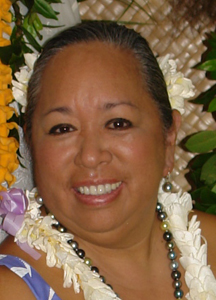 Photo: 2010-2011 Mellon-Hawai‘i Doctoral Fellow Noe Noe Wong-Wilson.
Photo: 2010-2011 Mellon-Hawai‘i Doctoral Fellow Noe Noe Wong-Wilson.
The largest population of Native Hawaiians in the entire University of Hawai‘i system is at HCC, where they make up 40.2 percent of the student population. It serves not only as my research site, but allows me to make the largest impact and contribution for my own people and their future. I have been able to bring the focus of my lifework, scholarly pursuit, and passion together in this one effort to help Native Hawaiian students succeed in college and in whatever pursuits they choose for themselves in life. —Noe Noe Wong-Wilson
Doctoral Fellow Noe Noe Wong-Wilson is currently the Native Hawaiian Student Success Coordinator at Hawai‘i Community College (HCC) on Hawai‘i Island. She has been instrumental in establishing the Paepae ‘Ohua Student Success Center at the college and has served as the College’s Coordinator of the Achieving the Dream initiative, a movement to address the success of underserved, underrepresented populations enrolled at Community Colleges across the nation.
Wong-Wilson is a graduate of Kamehameha Schools. She received a certificate of achievement in Hawaiian lifestyles from Hawai‘i Community College, a bachelor's in anthropology from the University of Hawai‘i at Hilo and a master's in Pacific Island studies from the University of Hawai‘i at Mānoa.
Wong-Wilson will complete her doctoral program in residence at the University of Waikato’s School of Maori and Pacific Development in Hamilton, New Zealand. Her thesis topic is “Achieving the Dream at Hawai‘i Community College: An Initiative for Native Hawaiian Student Success.” University of Hawai‘i professor Hamilton I. McCubbin, Ph.D., is her mentor.
Building on her mastery of culture and language and dedication to teaching, Wong-Wilson exemplifies the vision of the Mellon-Hawai‘i Fellowship program in her commitment to publish her doctoral research on improving academic achievement and success of Native Hawaiians in higher education. The Mellon-Hawai‘i Fellowship program, by its dedication to providing opportunity and core support to the academic advancement of future leaders with a passion for science and culture, will insure the well-being of indigenous people in Hawai‘i and the world. —Dr. Hamilton I. McCubbin

The Diving Women of Jeju Island
By Grace Ha, Fulbright Scholar and 2009 Cornell EES Program graduate
 Photo: Grace (right) at the blessing of the HPA school garden.
Photo: Grace (right) at the blessing of the HPA school garden.
I originally joined the EES program to learn more about environmental science and marine biology. I did not expect to become fascinated by traditional Hawaiian stewardship of the land and ocean. My own heritage is Korean, and when I came across a blurb about the diving women of Jeju Island (an island off the southern tip of the Korean peninsula, and also coincidentally called the “Hawai‘i of Korea”), my curiosity was piqued about what traditional Korean understanding of the ocean could be. I was curious as to how other maritime island cultures approached the ocean, using their own very limited natural resources. The Fulbright Fellowship seemed to be the perfect venue for me to explore my interest, and my teachers from Hawai‘i were very supportive of my proposal. I will be spending my Fulbright year in South Korea, doing a research project on indigenous understanding and utilization of the ocean on Jeju Island. After I finish school and my Fulbright year, I would like to pursue a Ph.D. in marine ecology.
 Photo: Grace examining a sea cucumber.
Photo: Grace examining a sea cucumber.
I really only know the very basics about the diving women on Jeju Island—they dive for sustenance, including algae, marine invertebrates, and other edible seafoods. This tradition does still continue, but it is dying out—the median age for haenyo (the Korean word for these women) is over fifty now, largely because the younger generation of women on the island are choosing other careers. These women, as well as the Korean culture's approach to the ocean and using the ocean, are who and what I wish to study. There is very little published in English on traditional Korean use and understanding of marine resources. At the same time, the Asian market is often targeted as a major cause of human disruption of ocean ecosystems, whether via whale hunting, shark fin hunting, or even hagfish hunting (they are used to make “eel skin” products which are popular in Asia). There seems to be a large disconnect between American marine conservation and Asian demands for sea products, at least from an American perspective. Jeju Island is known for its distinct maritime culture and its historical connections with the ocean; it is also currently a place in transition as the tourism industry has taken hold on the island, very similar to what has been happening in the Hawaiian Islands. I am going to the island to learn about the marine nature that is there, both from a scientific and a local/traditional perspective, and to better understand how the people there view the changes that are happening to their environment, especially in relation to the perspective their ancestors may have had to their environment.
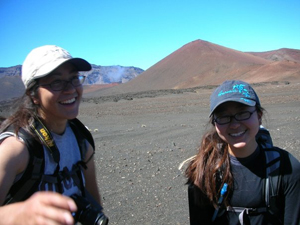 Photo: Victoria Wells (left) and Grace Ha (right) hiking in Haleakala Crater in spring 2009.
Photo: Victoria Wells (left) and Grace Ha (right) hiking in Haleakala Crater in spring 2009.
My time in Hawai‘i was actually what inspired the idea that became my Fulbright proposal. I had many amazing experiences while in Hawai‘i, but among the most memorable was hiking across Haleakala Crater and interning with John Pipan of the Mauna Kea Soil and Water District and Yvonne and Keoki Carter of Ka‘ūpūlehu Dry Forest Preserve. The EES program gave me a chance to step out of my comfort zone and to experience first-hand the natural phenomena so many others only learn about through textbooks. Most people think of sun and beaches when they hear Hawai‘i, and for many who come to these islands, that is all they bother to see. The EES program challenged me to explore, physically and intellectually, not only the unique natural history of the Hawaiian Islands, but also to appreciate the context of the Hawaiian culture and the issues that threaten the environment. For me, it was a life-changing experience that continues to enrich my studies back on the Cornell campus.
 Photo: Grace (seated on left) collecting ‘akia seeds in Waiakamali Watershed.
Photo: Grace (seated on left) collecting ‘akia seeds in Waiakamali Watershed.
Tracking carbon emissions in Hawai‘i—actually counting up the amount of carbon our group expended in our daily lives, calculating the number of trees it would take to reduce our contribution of greenhouse gases, and then planting that many trees (something like 500)—made the idea of a “carbon footprint” and how large mine was a reality for me. Previously, I knew the American lifestyle was not environmentally sustainable, but the idea that change needed to happen was still just a concept that didn't have a great deal of impact on my daily life. Having returned from Hawai‘i, I am much more conscious about how certain choices I make could have an unexpectedly largely impact on the environment. For instance, transportation of food products across vast distances is a major source of carbon emissions; therefore, when I get the chance, I try to buy locally grown products. Also, whenever I can, I try to talk to people about why sustainability is important and why they should care about the fate of our planet.

Re-growing a Forest or Two
Story and Images by Alexandra Moore, Cornell EES Program Director
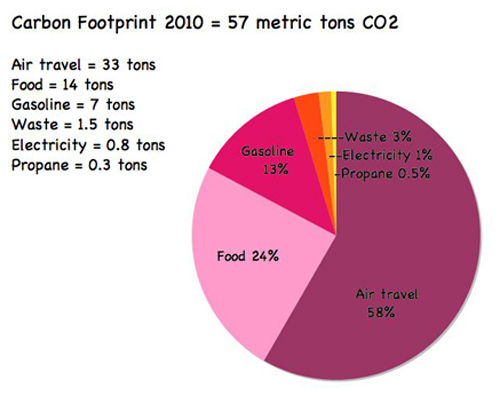
Defining our carbon footprint was the first challenge undertaken by the 2010 EES class. First, we define our terms. “Carbon-neutral,” in current usage, refers to a balance of carbon dioxide emissions and uptake. If we were to concern ourselves with other greenhouse gasses or effects we would be “climate-neutral.” Next, the students quantify the CO2 emissions associated with the operation of our program. The best strategy is always to reduce or eliminate CO2 emissions. Those emissions that cannot be eliminated are then offset. We break down our total emissions into six categories: air travel, ground travel, electricity, propane, food, and waste.
Our total CO2 emissions this year came to 57 metric tons. Not surprisingly, air travel is the single largest source of CO2 (58%) and the area in which we have few opportunities for reduction. Surprisingly, our second-largest source of emissions was food (24%), followed by ground travel (13%). Domestic energy consumption is less than 2% of our total, thanks to the renewable energy efforts of HPA, our host, as well as our tropical location and Waimea's natural breezes for air conditioning.
So, how do we offset 57 tons of CO2? We re-grow a forest, or two. Historically, land-use change and forest clearing have accounted for approximately 20% of the human-caused CO2 input to the atmosphere. Forests provide a variety of ecosystem services: they reduce erosion and retain water in a watershed, they provide habitat for innumerable plants and animals, and they sequester carbon in soil and biomass. A functioning forest is self-sustaining. As trees grow they add organic matter to the soil and seeds to the surrounding seedbank. As they age and die they create the substrate for the regeneration of new trees. We have already seen these processes in action at our two project sites, which is very encouraging.
When we began this project a year ago we did not fully appreciate the effort required to grow a native Hawaiian forest. We were familiar with the need to fence and weed a forest enclosure. We began our project by collecting seeds of native plants and working in the state tree nursery to clean and propagate the seeds. We laid irrigation lines at the outplant sites and did lots (and lots) of weeding.

This year we worked with our two partners, the Kohala Watershed Partnership and the Dryland Forest Working Group at Ka‘ūpūlehu, to outplant native trees, shrubs, and groundcover in two remnant forest enclosures. In 2010, we planted more than 600 individual plants comprising 26 native species. Of these species, 27% are indigenous, while the remaining 73% are endemic to Hawai‘i. Of the endemics, 23% are federally listed endangered species, some so rare as to be the offspring of only a handful of wild plants. As the plants grow, each species sequesters variable amounts of CO2.
Large trees (e.g., a mature ‘ōhi‘a or koa) are capable of removing and holding more than 20 tons of CO2, while an “average tree” accounts for about one ton of sequestered carbon dioxide. On a species-by-species basis we calculate the CO2 sequestration of our outplants at their mature size, incorporating a mortality rate of 20%. Our 600 outplants are calculated to sequester 214 tons of CO2 over the course of their lifetimes.
This year we also had the opportunity to monitor our reforestation efforts from 2009. We measured the growth of the trees that were planted last year and were astonished to see how rapidly some of these species have gained mass. Growth rates ranged from 5–150 times the original biomass.
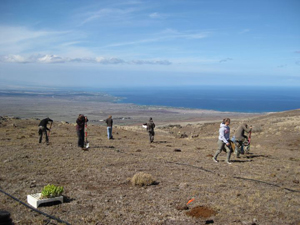
Photo: The “forest” on Kohala Mountain. Cornell volunteers work with KWP staff to prepare an outplant site in the restoration corridor.
While the trees are small they grow very rapidly, but as they mature their growth rate will slow. Our initial measurements suggest that the time frame required for our outplants to balance our CO2 emissions is less than a decade. This time scale is appropriate for carbon-neutrality, as the residence time of CO2 in the atmosphere is on the order of several decades. 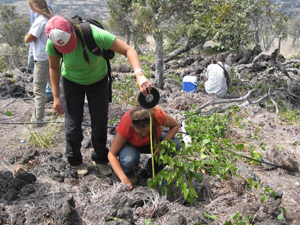
Photo: Ka‘ūpūlehu: students monitor the growth of trees planted in 2009.
Since we began, our students have been involved in nearly every aspect of forest stewardship, including working in and around the sites after outplanting. Many of our students have chosen to conduct their capstone volunteer internships with the Dryland Forest Working Group, the Kohala Watershed Partnership, and the Hawai`i Wildfire Management Organization, working to maintain and mālama these special places. As we pack up and leave, what we take with us is not only a better understanding of sustainable living, but also a very personal connection with the ‘āina and with our friends who live and work here on Hawai‘i Island.

It was pretty incredible to see students in middle and high school doing university-level scientific research projects and data collection. Their questions and experiments were focused on real environmental issues, and posed mental and sometimes physical challenges that were rewarding to both students and teachers. We noticed that some students who don’t do that well in school really loved being in the field, and excelled in doing hands-on science.
–Samantha Birch, Field Educator for The Kohala Center and HI-MOES Outdoor Educator
Participating students have been invited to apply to a week-long HI-MOES Science Camp this summer. Selected students will visit rainforest, reef, tide pool, and stream sites and hone their scientific methodology and data collection skills. “We are hoping these students will then be well prepared to mentor next year’s newer students,” explains Birch.
Schools that participate in the program again next year will be encouraged to improve their science projects, collect longer-term data, and integrate their research with work being done by other HI-MOES schools. Plans for next year include expanding the program to serve Hilo schools. “Adding schools in the Hilo Bay Watershed is exciting, as Hilo is a whole different environment filled with potential study topics,” remarks Birch.
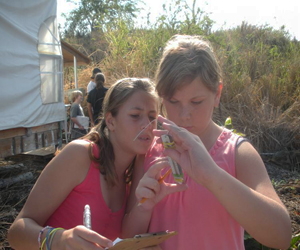 Photo: Innovations School students researched the ecological differences between the wet and dry forest on Pu‘u Kawaiwai. Students did a survey of plants and animals, and they also compared the soil composition, soil temperature, soil moisture, soil absorption and percolation, air temperature, and relative humidity of the two forests.
Photo: Innovations School students researched the ecological differences between the wet and dry forest on Pu‘u Kawaiwai. Students did a survey of plants and animals, and they also compared the soil composition, soil temperature, soil moisture, soil absorption and percolation, air temperature, and relative humidity of the two forests.This year’s HI-MOES field research projects included:
Pu‘u Kawaiwai Ecological Study by Innovations Public Charter School
Hawai‘i Cloud Forest: An Inquiry Into Moss by Innovations Public Charter School
Tide Pool Survey by West Hawaii Explorations Academy
A Field Study Comparing Kahalu‘u Bay and Kūkio Bay, their Substrate and Water Chemistry by Hualalai Academy
 Photo: Hualalai Academy HI-MOES students at Kūkio Bay.
Photo: Hualalai Academy HI-MOES students at Kūkio Bay.
The Components of a Watershed by West Hawaii Explorations Academy
Po‘o Hawai‘i Restoration Pao‘umi Heiau - Plane Table Mapping by Ke Kula ‘o ‘Ehunuikaimalino
Comparing Kahalu‘u Beach Bark with Kūkio Beach Park: Marine Water Quality, Human Activity and Impact by Kealakehe Intermediate School
Do the Characteristics of Soil, Insect Diversity and Plant Abundance Differ at Three Sites: Pu‘u o ‘Umi, Waiakamali Gulch, and the Koai‘a Reserve? by Hawaii Preparatory Academy
Dissolved Oxygen Changes Over Time by Kealakehe High School
Kohala Rainforest Field Experiments: Moss Diversity in the Kohala Forest; Fern Abundance in the Kohala Forest by Waikoloa School
To learn more about each school’s project, visit http://www.kohalacenter.org/himoes/schools.html. Check out the science conference proceedings and PowerPoint presentations at http://www.kohalacenter.org/himoes/conference.html.
Read "Nature, uninterrupted: West Hawaii students examine various ecosystems" by Carolyn Lucas, a front-page story in the May 5 edition of West Hawaii Today.

Work Hard, Compost, and Other Farm Survival Skills
By Una Greenaway

In Hawai‘i, as with the rest of the U.S., too many of the foods consumed are processed. People have lost touch with growing and eating the kinds of food that we grow in Hawai‘i. We need to teach children the importance of their diet to their health.
Over the years, we have worked really hard to create a balance between growing our cash crops—organic Kona coffee and macadamia nuts—and all the other foods that we grow for our own consumption. It takes a lot of coordination to grow, harvest, and process multiple crops. We have also worked hard to become energy self-sufficient. We generate all of our electricity from the sun, and we catch rainwater.
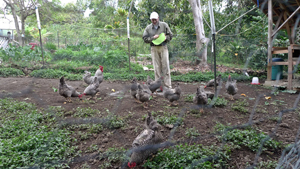
Photo: Una’s husband, Leon Rosner, feeds the chickens.
In order for farms to be successful, farmers need to create value-added products. To supplement our income we sell coffee, macadamia nuts, macadamia nut butter, jellies, dried bananas, and chocolate candy. I also conduct farm tours. Recently, I have created a small five-family CSA (community supported agriculture) program to sell our vegetables, fruits, avocados, and eggs. The shortage of certified kitchens in the Kona districts makes it difficult for farmers who want to process and sell their own products.

Photo: Kuaiwi Farm homegrown organic chocolate candy.
Water has become a huge challenge for farmers in Kona and in other areas of the island. Farmers need to be creative in the ways they use and conserve water. Building more water catchment tanks can really help when the government cannot supply adequate water. 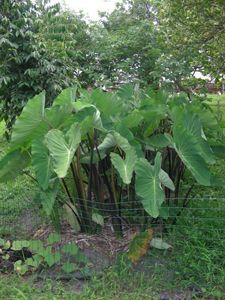 It is also extremely important to build up the moisture-holding capacity of the soil with plenty of organic matter, and to hold moisture in with mulch.
It is also extremely important to build up the moisture-holding capacity of the soil with plenty of organic matter, and to hold moisture in with mulch.
Invasive species are also posing serious problems for farmers. The Varroa mite is spreading rapidly on Hawai‘i Island, killing feral bee hives. Soon the only bees on the island will be those that are in managed hives. The Little Fire Ant also has the potential to devastate tree crops as it spreads across the island, making it impossible to harvest those crops.
Photo: Taro.So, what do you need to know to survive as a farmer? You need to be flexible. Grow what you like first. Work on your marketing. Make sure you have adequate water on your property. Compost. Learn bookkeeping. And, last but not least, make some time to have fun and regenerate!
Learn why Una Greenaway was selected as a 2010 Sustainable Farming Mom of the Year by the Women, Food, and Agriculture Network at http://wfan.org/News/Entries/2010/5/10_2010_Sustainable_Farming_Moms_of_the_Year.html.

